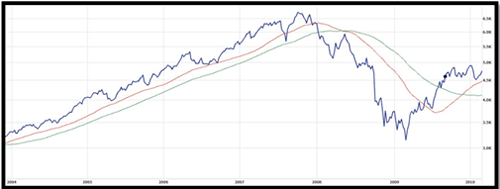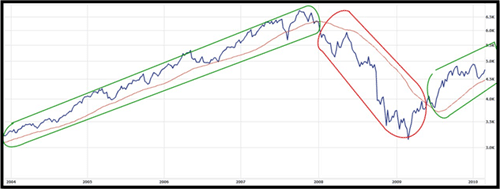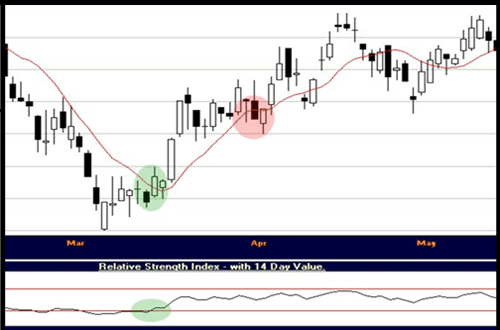What could possibly be secret about the well know and simple tool of moving averages? Surprisingly, many do not appreciate how much a moving average can tell you about trend, and even more will ignore the powerful buy and sell signals generated. For those interested in taking their trading to the next level….read on.
Moving Averages and the Long Range Trend
Sound investment will usually start with the very big picture and narrow it down to a precise trading window. The big picture should include what the overall market is doing, and a careful examination of a multi-year trend with a particular stock. You should never trade against the current market sentiment or the long term trend of a stock. What is market sentiment? That will be discussed in another article. How do we determine the long-term trend with moving averages? We will answer that right now.
Two key averages to memorize are:
- 350 day moving average
- 200 day moving average
The 350 and 200 Day Moving Averages
The first goal is to see if the particular stock seems to have a correlation to a long term trendline or moving average. Put the stock on a chart with both averages (simple moving averages). Does the price seem to bounce off a certain moving average? Some stocks will have no relevance with these long term moving averages but the majority will.
6.5 year chart of ASX 200 with 200 and 350 day simple moving averages

If either the 200 or the 350 day moving average seems to have some interaction with prices, then use exclusively that one. With the ASX 200 in the above chart, the red line seems to have more relevance which is the 200 day moving average.
Quick tip for 200 and 350 day moving averages
Try the settings on both simple and exponential moving averages for the best fit with price data
On the chart below the 350 day moving average has been removed since it had little correlation to the price of the stock. Furthermore, I drew green circles when the price was above the 200 day moving average and red circles when the price was below the 200 day moving average. This allows the trader to quickly see the long term trends and which one they are in right now.
ASX 200 with 200 day moving average

According to this chart, the ASX 200 is in a current bull trend. As well, the prices have recently bounced off the average. This means we should only invest long at this point in time.
REMEMBER: prices above the long term moving average mean a bull trend; prices below mean a bearish trend.
The 50 Day Moving Average
Now that we know the long term trend of the stock, we would like to zero in on another important aspect: institutional support.
The big players in the market with the most clout are often the most predictable. Managers of multi-million dollar funds are not able to buy and sell as easily as a trader with 10 or 20 thousand dollars. As such, they will often use predictable techniques to slowly buy and sell.
One technique they have used for a very long time is the buying and selling at the 50 day moving average. If you notice a certain stock seems to bounce along the 50 day moving average, you might reasonably conclude that institutions are interested in this stock. Institutions are a welcome sight in stocks IF they are accumulating. If the tables turn and the stock drops below this value, the large players might start to liquidate which could have disastrous effects.
The key is:
- Look for a correlation between prices and the 50 day moving average
- If there is, consider timing purchases after bounces and sell when price makes serious break below the 50 day moving average.
BHP Billiton Limited (BHP) with 50 day moving average

BHP has a very tight relationship with the 50 day moving average (the red line). I have highlighted in green the bounces off the 50 day moving average. The red circles show punctures of the 50 day moving average where caution is warranted.
A very simple trading system could be used with this chart. Buy on each bounce or even when price pops above the 50 day moving average and sell after 5 – 10% gain. This is important for even long term buy and hold investors to know if institutions are holding prices up or pushing them down. As of the beginning of March, the price is still being held under water by the 50 day moving average.
Knowing the sentiment of institutional investors will give you a strong edge.
The Short Term Moving Average Trigger
The final moving average we will discuss is for short term triggers to be used with other indicators only. The particular moving average we will use is the 10 day, although some traders will use the 20 day. I have found the shorter term one more proficient.
How do we use the 10 day moving average? One method is as a stop loss. Imagine our trading system gets us into a short term trade, perhaps with highly leveraged CFD’s or options. Using the 10 day moving average will get us out the trade. Particularly is this useful for momentum buying.
Amcor Limited (AMC) with 10 day moving average and RSI indicator

We will use the 10 day moving average as our trigger to buy and sell. If the RSI gives a buy signal (see RSI article), we wait until prices move above the 10 day moving average.
Once prices fall below the 10 day moving average we sell with our short term trade.
With this stock we bought around 4 dollars and sold at 4.50 for a 12.5 percent profit.
Trading the 10 day moving average can be incorporated into almost any system. If your technical indicators say buy but the prices are below the 10 day moving average, wait until it rises above as confirmation. If the technical indicators say sell, you are welcome to wait until the 10 day moving average is pierced. Often, the 10 day moving average will indicate buy and sell orders before the other indicators.
Moving Averages are Powerful
Understanding long term to short range moving averages are powerful aids to healthy trading. In fact, moving averages are the basis for many other technical indicators. Remember the three basic ways we use them: to determine long term trend, to see if institutions are actively trading the stock, and a short term trigger for buying and selling. Follow these three simple rules and profitable trading will be yours.